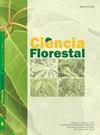Biomass and carbon in Schizolobium parahyba var. amazonicum stands under different spacing
IF 0.5
4区 农林科学
Q4 FORESTRY
引用次数: 0
Abstract
Native species planted in areas previously occupied by degraded pasture can play an important role in biomass supply and atmospheric carbon sequestration. Evaluating the performance of native species in different planting spacings becomes important for forestry and the management of new species with economic potential. Schizolobium parahyba var. amazonicum is a non-traditional species in the southeastern region of Brazil and it was established in pasture areas to evaluate growth, biomass, and carbon stock. Five planting spacings (3 m x 2 m, 3 m x 3 m, 4 m x 3 m, 4 m x 4 m, and 5 m x 5 m, in monoculture) were tested in 9 experimental plots. The biomass of the shoot and root, as well as the carbon content, were obtained by the direct method. The biomass varied 31.4 and 52.9 kg tree-1 in the spacing 3 m x 2 m and 5 m x 5 m, respectively. The greater carbon stock was observed in the lower spacing (19.43 Mg ha-1), 50% higher than in the larger spacing. The spacing did not influence the biomass and carbon stock in the roots per unit area. The performance of the species should be monitored at advanced ages given the different responses to planting spacing and competition between plants.不同行距下亚马孙副半裂菌生物量和碳含量
在退化草场上种植的原生物种在生物量供应和大气固碳方面发挥着重要作用。评价不同种植间距下本地树种的表现对林业和具有经济潜力的新树种的管理具有重要意义。副hyba var. amazonicum是巴西东南部地区的一种非传统物种,为评价其生长、生物量和碳储量而在牧区建立。在9个试验田进行5种种植间距(3米× 2米、3米× 3米、4米× 3米、4米× 4米和5米× 5米)的试验。用直接法测定了茎部和根部的生物量以及碳含量。在3 m × 2 m和5 m × 5 m的间距上,生物量变化分别为31.4和52.9 kg。低间距的碳储量(19.43 Mg ha-1)比大间距的碳储量高50%。间距对单位面积根系生物量和碳储量没有影响。考虑到不同物种对种植间距和植物间竞争的不同反应,应在高龄时监测其生长性能。
本文章由计算机程序翻译,如有差异,请以英文原文为准。
求助全文
约1分钟内获得全文
求助全文
来源期刊

Ciencia Florestal
农林科学-林学
CiteScore
0.80
自引率
0.00%
发文量
85
审稿时长
18-36 weeks
期刊介绍:
The journal Forest Science was established in 1991 with the goal of being a vehicle for dissemination which are published works tércnico-scientific forest-related, the following bodies crowded the Centro de Ciências Rurais of Universidade Federal de Santa Maria:
- Centro de Pesquisas Florestais - CEPEF
- Programa de Pós-graduação em Engenharia Florestal - PPGEF
- Departamento de Ciências Florestais - DCFL
MISSION:
Publish scientific papers, technical notes, and literature reviews related to the area of forest sciences.
 求助内容:
求助内容: 应助结果提醒方式:
应助结果提醒方式:


